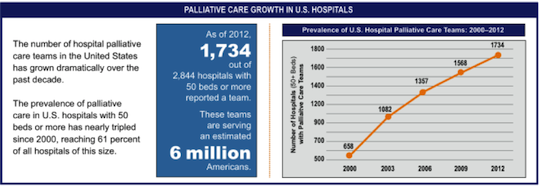Data/Experts Say Palliative Care is in High Demand
According to results of the recently released National Palliative Care Registry™ Survey, the prevalence of palliative care in U.S. hospitals with 50 beds or more has nearly tripled since 2000, reaching 61 percent of all hospitals of this size. The number of people served by palliative care programs in the United States has also tripled, due to the increase in the absolute number of programs and their ability to care for a greater number of people living with serious illness.

“What this undeniable growth means for people with serious illness is that wherever they are in the country, in whatever setting they are in, they have access to the added layer of support they need to improve their quality of life and ensure that their families are well cared for,” said Sean Morrison, MD, Director of the National Palliative Care Research Center in a recent video about the future of palliative care.
In this video, Stephen Berns, MD, Asst. Professor of Geriatrics and Palliative Medicine at the Icahn School of Medicine at Mount Sinai Hospital, says he and his colleagues are seeing a positive change within their institutions as well, with more primary care physicians taking notice of the benefits this specialty has to offer.
Despite this growth however the data shows that insufficient staffing continues to present a barrier to reaching patients in need. Diane Meier, MD, Director of CAPC, says that in addition to limitations on workforce capacity, lack of understanding of the importance of concurrent palliative care services continues to serve as a barrier.
“Improving access to palliative care for all seriously ill people requires that every clinician have basic skills in pain and symptom management and in communication about what is most important to patients and their families,” says Dr. Meier. To view the entire survey summary, click here.